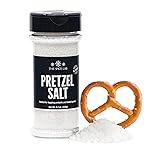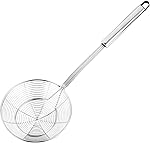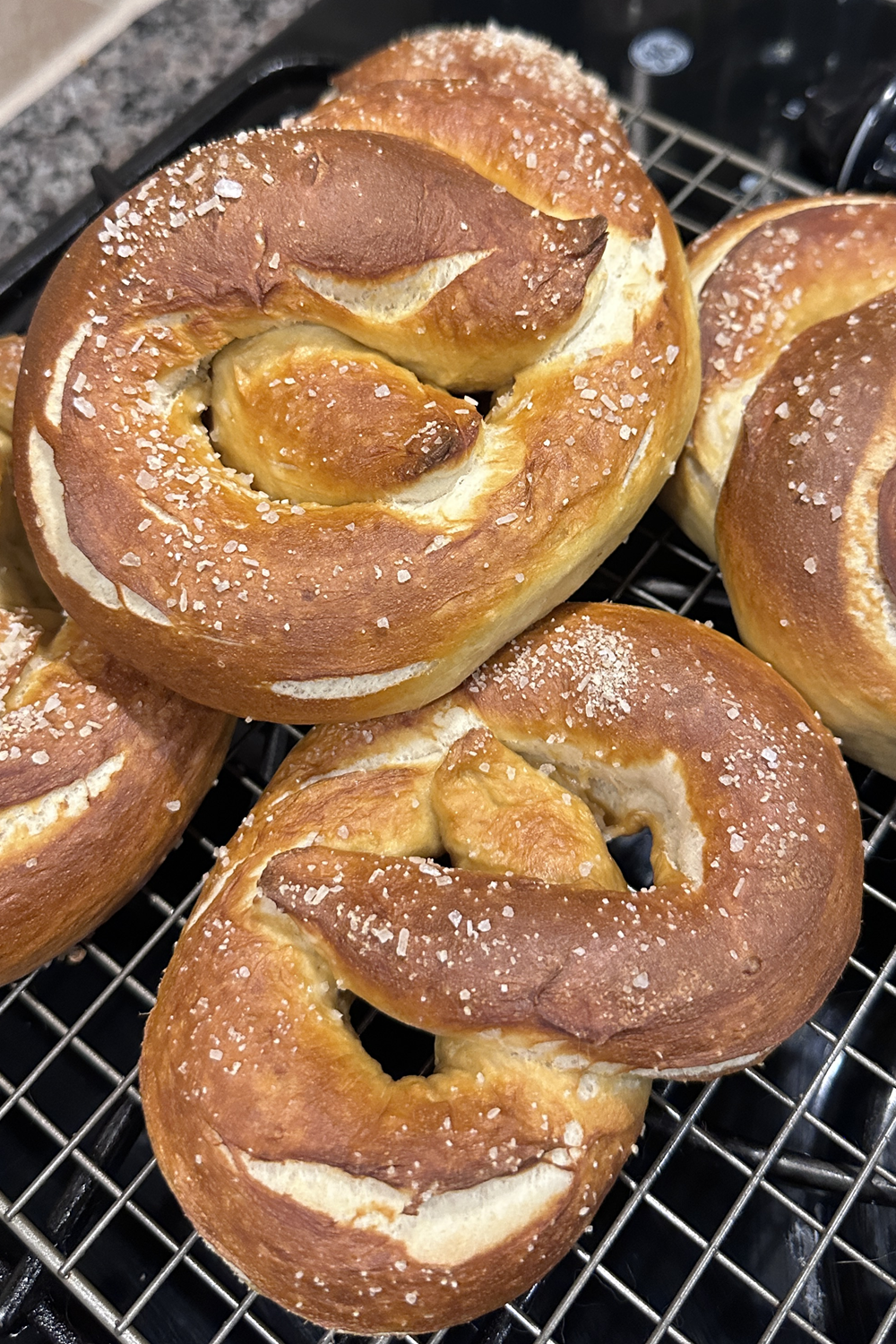These German soft pretzels deliver authentic bakery-quality results, with a golden-brown exterior, a pillowy-soft interior, and a rich, malty flavor from using beer directly in the dough. This traditional German pretzel recipe requires just a handful of ingredients and creates six generously sized pretzels perfect for pairing with cold beer and spicy mustard. I've made this recipe multiple times to perfect the technique with modern ingredients while staying true to its German roots. It's always a hit!
Warm beer activates the yeast while infusing every bite with subtle malty depth and a hint of sweetness. When you bite through the coarse salt-crusted exterior into the tender, slightly chewy center, you'll taste why these pretzels have been a beloved German tradition for centuries.
The smell of fresh-baked pretzels is intoxicating - that distinctive combination of toasted malt, warm yeast, and browned butter. It’s a combination perfected over generations in German beer gardens and biergasthauses: the slight tang of beer in the dough, a satisfying snap of the deep brown crust, and the glint of coarse salt on a classic pretzel, all balanced by a foaming stein of cold beer.
These aren’t the sugar-laden, factory-made pretzels at an airport kiosk. This is the real deal: beer in, bakery out. You want all of the flavor? Follow the steps. Skip the shortcuts. German bakers weren’t guessing, and neither should you.
German Pretzels in the Old Country
Pretzels trace their origins back to 610 AD, when an Italian monk reportedly twisted strips of dough to resemble children's arms crossed in prayer, calling them pretiola or "little rewards" - though German bakers had so thoroughly claimed the tradition by 1111 that the pretzel became the official symbol of their guild. By the post-war era, these twisted breads had become central to German identity.
In post-war Germany, pretzels were woven into the fabric of daily life. While American housewives were experimenting with Jell-O molds and TV dinners, German hausfrauen were maintaining centuries-old baking traditions, including the art of Brezel making.
Walk into any German bakery in the 1950s and 60s, and you'd find pretzels piled high in wicker baskets, their twisted forms catching morning light through shop windows. Radio broadcasts of popular Schlager music filled kitchens as women kneaded dough by hand; no stand mixers yet in most homes. The weekly market meant fresh yeast wrapped in paper, flour bought by the kilo, and beer purchased in returnable bottles from the local brewery.
Pretzels served a social function beyond sustenance. They appeared at Oktoberfest celebrations, church festivals, and Sunday afternoon gatherings where neighbors shared gossip over coffee and beer. The tradition of dipping pretzels in butter or pairing them with Leberwurst and sharp mustard was as routine as Americans reaching for chips and dip. Making pretzels at home was a weekend ritual, often a family affair where children helped shape the dough, though rarely achieving the perfect twisted form on their first try.
What Makes These German Soft Pretzels Stand Out

German Soft Pretzels With Beer Recipe
Authentic German soft pretzels made with beer-infused dough create a golden-brown, chewy exterior and soft, pillowy interior. This traditional recipe uses warm beer to activate the yeast and add subtle malty flavor, then finishes with a baking soda bath for that signature pretzel crust. Perfect for serving with cold beer, spicy mustard, and good company.
- Total Time: 1 hour 32 minutes
- Yield: 6 1x
Ingredients
- 4 cups all-purpose flour
- 2 teaspoons salt
- 2 teaspoons sugar
- 2 packages active dry yeast (4 1/2 teaspoons)
- 1 1/2 cups warm beer, heated to 110°F
- 3 tablespoons baking soda
- 8 cups water
- Coarse salt or pretzel salt for sprinkling
- 2 tablespoons melted butter (optional, for brushing)
Instructions
- Combine dry ingredients: In a large bowl, mix together flour, salt, and sugar until well combined.
- Activate the yeast: In a separate bowl, warm the beer to 110°F (use a thermometer for accuracy). Sprinkle the yeast over the warm beer and let stand for 5 minutes until foamy and activated.
- Make the dough: Pour the yeast mixture into the flour mixture. Mix with a wooden spoon or stand mixer fitted with dough hook until a shaggy dough forms. Knead for 5-7 minutes until the dough is smooth, elastic, and slightly tacky but not sticky.
- First rise: Place dough in a lightly greased bowl, turning once to coat. Cover with a clean kitchen towel and let rise in a warm place for 1 hour until doubled in size.
- Preheat oven: Position rack in center of oven and preheat to 450°F. Line two baking sheets with parchment paper.
- Prepare baking soda bath: Bring 8 cups water to a boil in a large pot. Add 3 tablespoons baking soda and stir until dissolved. Reduce heat to maintain a gentle boil.
- Shape pretzels: Punch down dough and divide into 6 equal portions. Roll each portion into a 24-inch rope, keeping the middle slightly thicker. Form into a U-shape, cross the ends twice, then fold down to the bottom curve. Press ends to seal.
- Boil pretzels: Using a slotted spoon or spider, carefully lower each pretzel into the boiling baking soda water. Boil for 30 seconds, flip, and boil for another 30 seconds. Remove and place on prepared baking sheets.
- Top and bake: Immediately sprinkle boiled pretzels generously with coarse salt. Bake for 10-12 minutes until deep golden brown.
- Serve: Remove from oven and brush with melted butter if desired. Serve hot with cold beer and dark mustard.
Equipment

Schaller & Weber Bavarian Sweet & Spicy Mustard
Buy Now → Buy Now →
Buy Now → 
Stainless Steel Spider Strainer
Buy Now →Notes
- Beer selection: Use a German lager, pilsner, or wheat beer for authentic flavor. Avoid hoppy IPAs which can taste bitter.
- Yeast type: This recipe uses active dry yeast. If using instant yeast, you can skip the activation step and mix directly with flour.
- Prep Time: 20 minutes
- Cook Time: 12 minutes
- Category: Bread
- Method: Baked
- Cuisine: German
Nutrition
- Serving Size: 1 pretzel
- Calories: 310
- Sugar: 2g
- Sodium: 1850mg
- Fat: 3g
- Saturated Fat: 1g
- Carbohydrates: 58g
- Fiber: 2g
- Protein: 9g
How to Make Perfect German Soft Pretzels with Beer
Recipe Variations, Serving Ideas, and Storage
Recipe Variations
Frequently Asked Questions
Yes, but choose wisely for best results. German lagers, pilsners, or wheat beers work the best and provide authentic flavor. Avoid heavily hopped IPAs or stouts, which can impart bitter or overly strong flavors that overpower the pretzel's subtle taste. Room temperature beer is fine—you'll warm it before adding yeast anyway.
That’s usually a cold dough or lazy yeast. The dough should double, no excuses. Make sure your beer is between 105-115°F when adding yeast; too hot kills yeast, too cold won't activate it. Also, be sure your dough doubles in size during the rise; this can take longer than an hour in cool kitchens.
You can, but you won't get the authentic pretzel flavor, color, or texture. The alkaline bath is what creates that distinctive dark brown crust and slightly tangy pretzel taste. Skipping it results in bread rolls shaped like pretzels rather than true pretzels. The bath only takes a few minutes and makes all the difference.
If the dough keeps tearing, it likely needs more gluten development or is too dry. Knead for the full 5-7 minutes until elastic and smooth. If the dough feels tight and springs back too much when rolling, cover it and let it rest for 5 minutes to relax the gluten, then continue shaping.
Apply salt immediately after removing pretzels from the baking soda bath while they're still wet. The moisture helps salt adhere. Press gently to help crystals stick. If you wait until after baking, brush pretzels with melted butter or egg wash first, then sprinkle with salt.
While beer adds flavor, you can substitute equal amounts of warm water. For better flavor, add 1 tablespoon of barley malt syrup or honey to the water to replicate the malty sweetness beer provides. The texture will be similar, but you'll miss the subtle fermented complexity beer brings.
Knead for 5-7 minutes by hand or 3-5 minutes in a stand mixer with a dough hook until the dough is smooth, elastic, and slightly tacky. The windowpane test confirms proper kneading: stretch a small piece of dough, and if it stretches thin without tearing, it's ready.
Pale pretzels usually mean the oven temperature was too low or they didn't bake long enough. Pretzels need high heat (450°F) to develop proper color through the Maillard reaction. Also ensure your baking soda bath is at a full boil; a gentle simmer won't create the right chemical reaction for browning.
Yes, shaped pretzels can be covered and refrigerated for up to 8 hours before boiling and baking. This actually enhances flavor through extended fermentation. Bring to room temperature for 15-20 minutes before proceeding with the baking soda bath and baking.
Traditional accompaniments include spicy brown mustard, whole grain Dijon, beer cheese dip, or softened salted butter. For a full German experience, serve with cold lager, sliced radishes, pickles, German sausages, and obatzda (Bavarian cheese spread).
You'll know these pretzels are done when your kitchen smells like a German bakery and the crust has that deep mahogany color. That's not poetic; that's what properly made pretzels look like.
I spent 15 years in Germany watching bakers crank these out every morning. Same ingredients, same technique, same results. The recipe works because it's been tested by centuries of professionals who didn't have time for guesswork. You follow the steps, you get the pretzel. Pretty straightforward.
Now here's the deal: if you make these, leave a rating and tell me how it went. Did the dough cooperate? Did you nail the twist on the first try or the fifth? Your feedback helps other bakers figure out what actually works in a real kitchen.
And if you've got a pretzel story - maybe a biergarten in Munich, maybe your Oma's kitchen - drop it in the comments. I'm always curious where people's food memories come from.

0 comments